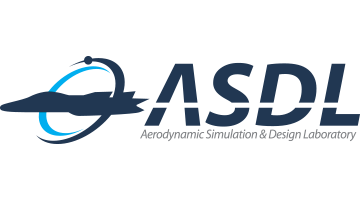Aerodynamic and Aero-optic Simulation of High-speed Vehicle
A Lateral thrust jet, another type of control system, exhausts a jet flow in the transverse direction and controls the flight path via the reaction force. Lateral jets show a short response time and high maneuverability regardless of the freestream density, so these systems are widely used for controlling high-speed vehicles. However, jet interaction phenomena occur in supersonic region, and a complicated flow structure is generated by the interaction of the shock wave, boundary layer flow, and vortex flow. Therefore, it is necessary to analyze the effect of the jet interaction flow in order to estimate the reaction force accurately.
Infrared sensing system is often used to correct the attitude and orbit of the high-speed vehicle. Sensors inside the vehicle’s head detect electromagnetic waves radiated from the target, and the control system determines whether the attitude or orbit needs to be changed based on the image data from the sensors. However, incident waves are propagated through an inhomogeneous density field, resulting in wavefront aberration, change of propagation trajectory, and reduction of intensity. These aero-optic phenomena act as an external noise to the sensor, so it is necessary to separate aero-optic noise from the observed data.
In our laboratory, a jet interaction flow analysis is performed on a lateral jet-controlled high-speed vehicle operating at various altitudes. Based on the results, the characteristics of the flow structure and the changes in the aerodynamic coefficients are analyzed. Furthermore, infrared wave propagation is numerically simulated via ray tracing algorithms to observe aero-optic errors.

(Left: low altitude, right: medium altitude)
Figure 1 shows numerical Schlieren around the high-speed interceptor with single lateral jet based on the computed density fields. At a low altitude, jet interaction region is located near the exit of the jet, and the jet flow is tilted toward the downstream. On the other hand, at a medium altitude, jet interaction region is developed much larger and stronger, and the flow structure generated by the jet interaction is pushed upstream. This indicates that flow structures due to jet interaction can affect the aero-optic characteristics of the vehicle’s head at medium altitudes.

Figure 2 shows the aero-optic sensing zone of the vehicle. At high angle-of-attacks, separation shocks and vortices are located right above the optical window. Since these flow structures have large density gradients, the electromagnetic waves coming from farfield could be much more distorted. Figure 2 also shows the numerical boresight error, the deviation with respect to the angle-of-attacks. At high angle-of-attacks, we can see that the change of the flow structure around the head could increase the magnitude boresight error.






